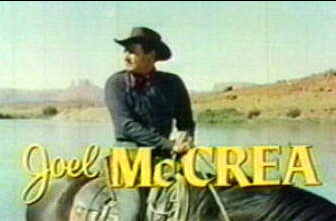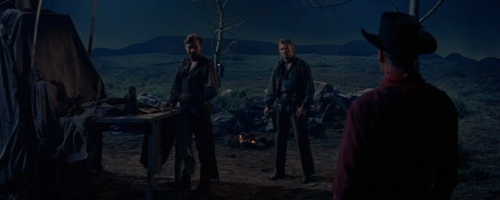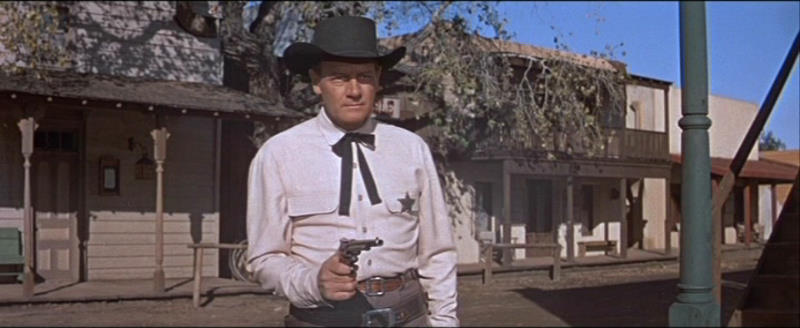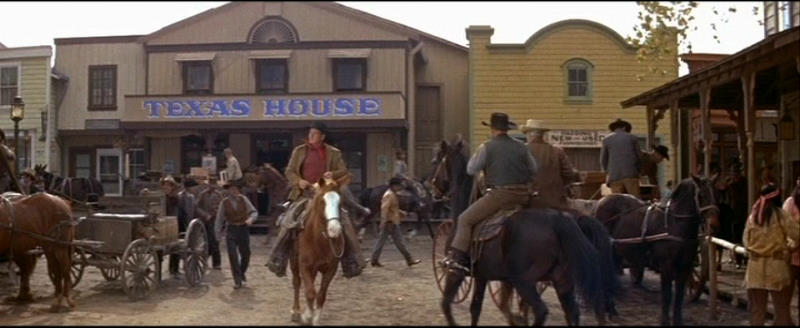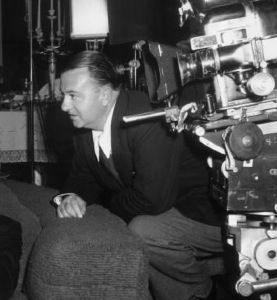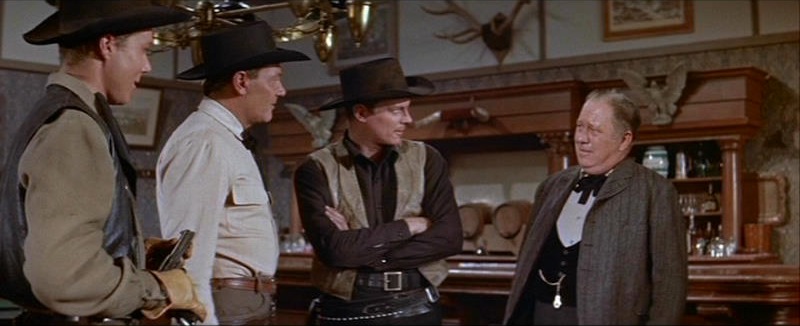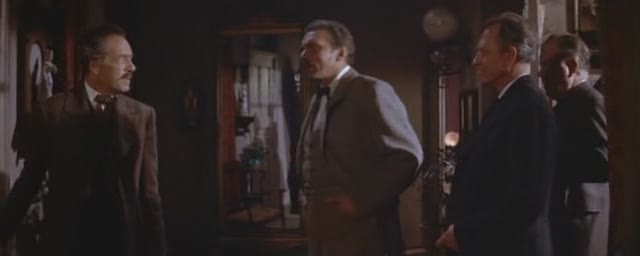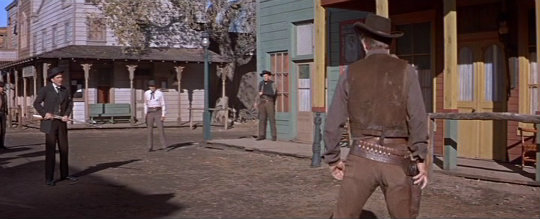From the Chicago Reader (December 5, 2003); also reprinted in my collection Goodbye Cinema, Hello Cinephilia. I’m delighted to report that Wichita became available on DVD, and in the correct CinemaScope format, in 2009. — J.R.
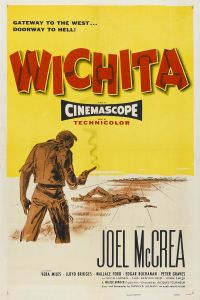
Wichita
**** (Masterpiece)
Directed by Jacques Tourneur
Written by Daniel B. Ullman
With Joel McCrea, Vera Miles, Lloyd Bridges, Walter Coy, Wallace Ford, Edgar Buchanan, Peter Graves, Jack Elam, and Mae Clarke.
One reason why Jacques Tourneur (1904-1977) remains a major but neglected Hollywood filmmaker is that elusiveness is at the core of his art. A director of disquiet, absence, and unsettling nocturnal atmospheres whose characters tend to be mysteries to themselves as well as to us, he dwells in uncertainties and ambiguities even when he appears to be studiously following genre conventions. In other words, his brilliance isn’t often apparent because he tends to stay in the shadows. As with Carl Dreyer, it took me years to fully appreciate the textures of his work, but now I can’t get enough of his films.
A case in point is Wichita (1955), Tourneur’s first film in CinemaScope and possibly the most traditional of all his westerns, showing in LaSalle Bank’s classic film series this Saturday. It’s full of actors associated with other westerns, including Joel McCrea, Vera Miles, Lloyd Bridges, Edgar Buchanan, Jack Elam, Walter Sande, Robert Wilke, and even a barely recognizable Sam Peckinpah in a bit part as a bank teller. The lead character is Wyatt Earp (McCrea) in the mid-1870s, before he became famous in Dodge City. (The real Earp served only as a policeman in Wichita, where he lived from 1874 to ‘76, before moving to Dodge City and working for three years as assistant city marshal.) He’s a wholly virtuous man who reluctantly accepts the job of marshal in Wichita to stop drunken cattlemen from terrorizing the locals, after being goaded into action by the accidental shooting of a five-year-old boy. Bat Masterson, a standard character in the Earp story, also figures in the action as a cub reporter. But despite these generic staples, there are plenty of times when the story seems to be taking place on Mars.
After the opening credits, for instance. They’re accompanied by Tex Ritter belting out the hokey title tune, which seems to recount the entire plot in advance -– as good a way as any of making us feel we’re in familiar territory. Then we’re out on the range with the cattlemen, whom we have no reason yet to see as villains. The first glimpse we get of Earp is as a tiny speck on the horizon, immediately seen by them (and therefore us) as an eerie potential menace. But they wind up inviting him to join them for dinner, and later two of the cattlemen–brothers named Gyp (Lloyd Bridges) and Hal (Rayford Barnes) –- try to steal his money when they think he’s asleep.
Gyp, Hal, and the other cattlemen seem to be the bad guys from this point on, and soon Earp seems to be not only a law-and-order man but an implacable killing machine and angel of death. Jacques Lourcelles describes the setup succinctly in his excellent Dictionnaire du Cinéma: “In Wichita, a city without law and without ‘values’ in the midst of a full economic boom, Wyatt Earp, the incarnation of these absent values, appears like a being from elsewhere, a sort of extraterrestrial.”
A Goody Two-shoes who’s also a little creepy because he’s an outsider, Earp seems solid only in comparison with the cattlemen, all-too-human louts who can’t help themselves, and with the local businessmen, who change their positions so often we can’t be sure what side they’re on. They’re confused in part because as soon as Earp gives up the idea of starting his own business and becomes marshal, he outlaws all guns in town except his own. This strikes most of the businessmen as too much of a good thing, because they fear the ban on firearms will be bad for trade (one of many details that feel up-to-the-minute). In the end no one’s really in control–not even Earp, who seems trapped in a destiny he’d rather avoid. To confuse matters further, Earp turns out to have a couple of brothers, who enter the film as potential villains before we realize who they are and why they’ve come to town. They create a disturbing rhyme with Gyp and Hal as we gradually discover that the main difference between “good” and “bad” is the direction in which the guns are pointed.
Two shocking accidental deaths from the cattlemen’s gunfire represent turning points in the plot, yet Tourneur’s staging of them is so quick, so dedramatized, and so peculiar that we can’t view them as ordinary climaxes. Instead they come across as incongruous quirks of fate, throwing both us and the characters off balance. This prompted whoever wrote LaSalle Bank’s blurb to remark, “The scene where the kid gets shot in the window could’ve used a retake.” That’s certainly true in terms of conventional dramaturgy: the boy immediately crumples and slides out of frame without any visual evidence that he’s been struck by a bullet. The staging might provoke derisive laughter, yet it also helps make us more queasy about the boy’s senseless death–something we might not feel if the action were more legible and pointed, the way John Ford might have filmed it. This death and a later one reminded me of the messy, absurdist deaths from gunfire in Jim Jarmusch’s 1996 antiwestern Dead Man, which also tend to provoke uneasy titters.
In the second part of the video documentary A Personal Journey With Martin Scorsese Through American Movies (1995) is a nine-minute stretch devoted to Tourneur that focuses on the first two horror films he directed for producer Val Lewton, the 1942 Cat People (made for only $134,000) and the 1943 I Walked With a Zombie. “In its own way,” Scorsese says, “Cat People was as important as Citizen Kane in the development of a more mature American cinema.” It seems an extreme statement, but it’s actually reasonable, because Tourneur and Lewton brought subtlety and poetic suggestion to B movies, while Welles brought a kind of intelligent bombast to A pictures. Both movies startled audiences –- Cat People ran longer at some venues than Citizen Kane –- but only Citizen Kane gained cultural prestige.
A short list of Tourneur’s best films would have to include those two pictures as well as the 1943 The Leopard Man (his final picture for Lewton and, in spite of a flawed ending, his most frightening), Out of the Past (1947), Stars in My Crown (1950), and Night of the Demon (1957 — cut and retitled Curse of the Demon for its U.S. release) –- all black-and-white chamber pieces. My second tier of favorites, mainly in color, would include the westerns Canyon Passage (1946) and Wichita.
All eight of these films have some noir elements, and the literal as well as metaphysical darkness helps define Tourneur’s stamp. (Chris Fujiwara’s definitive 1998 critical study, one of the best pieces of auteurist criticism I know, is aptly called Jacques Tourneur: The Cinema of Nightfall, with reference to the expertly made 1957 thriller Nightfall.) Other defining traits include an insistence on showing realistic light sources in interior scenes; a slightly surreal manner of lighting and filming exteriors that makes them feel like interiors; an emphasis on doorways, windows, and other thresholds in sets that are thoughtfully constructed and furnished; direction of actors that encourages underplaying and generally reflects the nuanced sensibility of an unostentatious humanist; and, more elusively, a preoccupation with death and a general sense that the universe is ruled by irrational elements. Tourneur believed to some extent in the supernatural and the paranormal but was too intelligent to come across as a crank; his interviews suggest he was more interested in the notion of parallel universes than in ghosts.
In short, what identifies a Tourneur picture isn’t strictly speaking a style, a manner, or a group of themes, but rather a way of perceiving the world -– one that perpetually finds ambiguities and leaves troubled impressions. This sensibility often works wonders in his genre films –- suspense, horror, fantasy –- and even when he focuses on spirituality, as in Stars in My Crown, with its small-town, late-19th-century preacher. But it may have hurt some of his other films commercially, even if they linger longer in our memories as a consequence.
Tourneur was the son of one of the most distinguished and cultivated filmmakers of the early silent era, Maurice Tourneur (1876-1961), who made films in France and the U.S. after working as an assistant to sculptor Auguste Rodin and as an actor. The son, by most accounts, had a difficult and somewhat lonely childhood in both countries, serving a protracted apprenticeship as a script boy, actor, editor, production assistant, and second-unit director, and throughout his career he regarded his own work with self-effacement -– though he was proud of his unusually respectful treatment of nonwhite characters.
Another thing that differentiates Tourneur from directorial grandstanders like Hitchcock and Welles is that he almost never chose his own material. He was notorious for almost never turning down an assignment, and his thoughtful rationale was that directors can’t be sure in advance whether they have something to bring to a project. He did fight to make Stars in My Crown, his first film with McCrea and understandably one of his favorites. He wanted to make it so badly he finally agreed to direct it for a pittance –- inadvertently lowering his salary for the remainder of his career. Apparently the only other time he took an active role in deciding what to direct was at the same studio, MGM, the same year, 1950, when he rejected Devil’s Doorway, saying the script was awful.
Tourneur is one of the few important American directors of the 50s who welcomed CinemaScope, arguing that “it reproduces approximately our field of vision,” “obliges the director to work harder,” “makes it possible to create interesting relationships between characters in the foreground and those in the background,” and “makes it necessary to compose.” Wichita, his first film in CinemaScope, is also, as Fujiwara points out, his major work in CinemaScope, though lamentably it’s almost impossible to see the film in that format. Turner Classic Movies, which generally letterboxes all widescreen films, cropped it horribly when screening it in 1999. The closest I’ve ever come to seeing it in the proper ratio was on a copy made from a British TV broadcast that showed the film in wide-screen proportions but trimmed both sides of the frame. I’ve been told that LaSalle Bank is screening a 16-millimeter ‘Scope print, but I don’t know how much of the original format will be visible and undistorted. [2008 postscript: Gabe Klinger, who attended that screening, reported back that it was a “reduction print”.]
This format matters, partly because Wichita is about the relationship between an individual and a community, and both the community and the setting (as well as their interplay) get reduced and simplified whenever the image is cropped. Here peripheral details count as much as empty space and off-center compositions–all of which get obscured when the image is mutilated to fit TV screens. I should add that Tourneur’s superb taste as a colorist would undoubtedly be enhanced by the full rectangular glimpses of the town, where some of the buildings are painted yellow, green, orange, and brown in striking juxtapositions.
Wichita superficially resembles some John Ford westerns because of Earp (a character in Ford’s My Darling Clementine and Cheyenne Autumn), because the romantic interest is played by Vera Miles (who would later turn up in The Searchers and The Man Who Shot Liberty Valance) and because the town has a newspaper run by an idealistic but ineffectual drunk (like Edmond O’Brien in The Man Who Shot Liberty Valance). But this shouldn’t lead one to suppose that the characters in Tourneur’s films belong to the same universe. The world of Ford is ruled by community, and everyone has a place. The world of Tourneur is ruled mainly by fear and terror, and nothing and no one remains fixed.
As Earp first approaches and then enters the town, we see three times in succession a placard and banner that reads, “Everything Goes in Wichita.” The slogan suggests freewheeling capitalism, raucous boozing, and womanizing — all implicitly equated –- but it eventually takes on an apocalyptic meaning, as in “Everything Goes to Hell in Wichita.” Bringing law and order to such a place is surely a noble activity, yet bringing it through one death after another may not be. Earp says he’s sorry before he dispatches the final villain, and because of Tourneur’s delicacy, we’re sorry too. “He shot it out with the worst men in Wichita,” sings Ritter at the beginning, “made every man lay his pistol down. No one fooled with the marshal of Wichita, and today it’s a very nice town.” Maybe, but thanks to Tourneur, I don’t quite believe it.
Published on 05 Dec 2003 in Chicago Reader, by jrosenbaum

